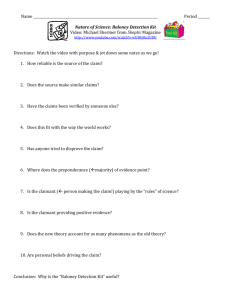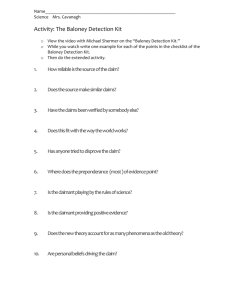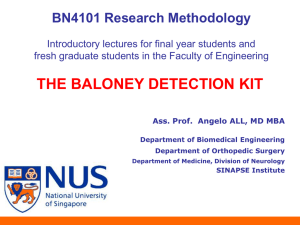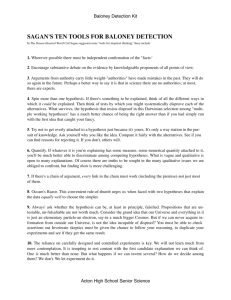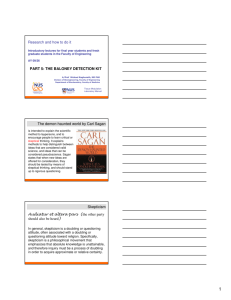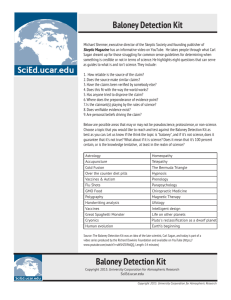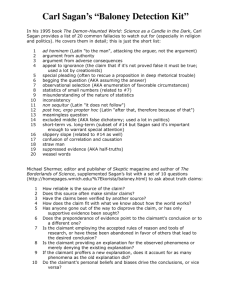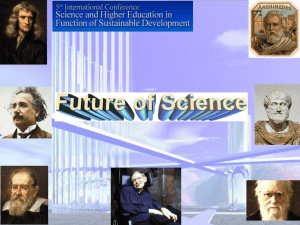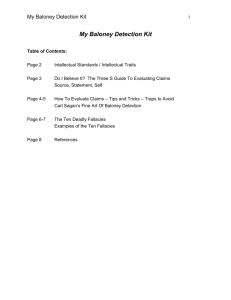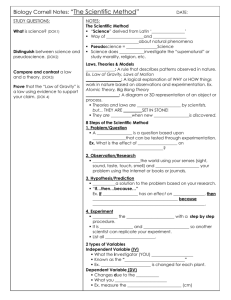Baloney Detection Kit
advertisement
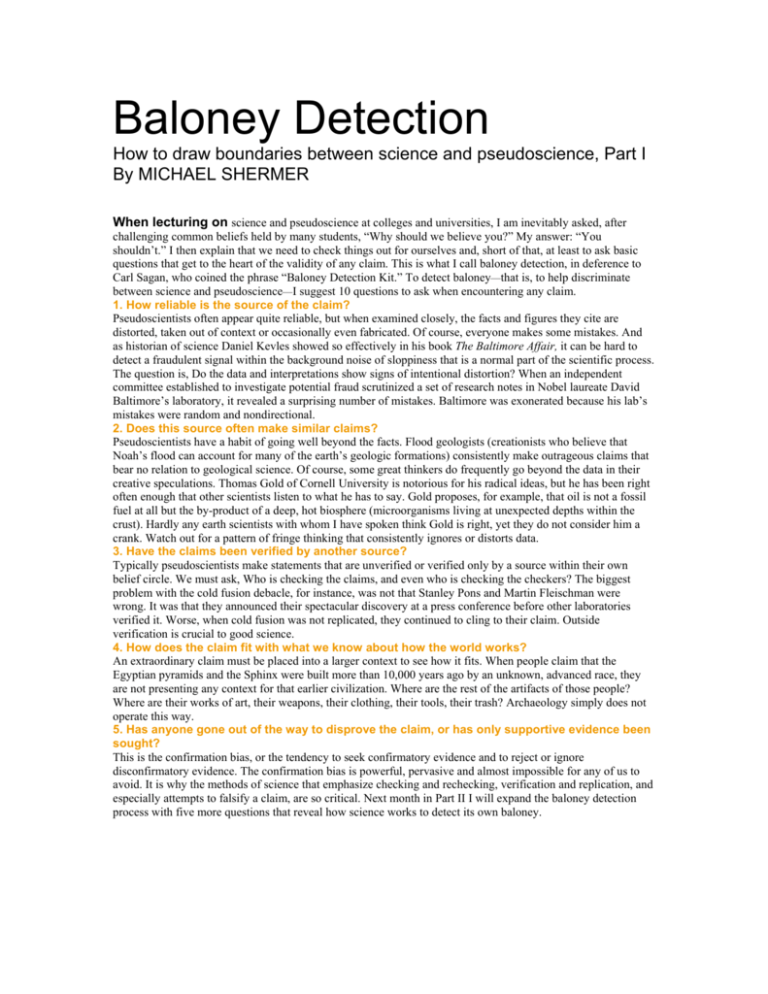
Baloney Detection How to draw boundaries between science and pseudoscience, Part I By MICHAEL SHERMER When lecturing on science and pseudoscience at colleges and universities, I am inevitably asked, after challenging common beliefs held by many students, “Why should we believe you?” My answer: “You shouldn’t.” I then explain that we need to check things out for ourselves and, short of that, at least to ask basic questions that get to the heart of the validity of any claim. This is what I call baloney detection, in deference to Carl Sagan, who coined the phrase “Baloney Detection Kit.” To detect baloney—that is, to help discriminate between science and pseudoscience—I suggest 10 questions to ask when encountering any claim. 1. How reliable is the source of the claim? Pseudoscientists often appear quite reliable, but when examined closely, the facts and figures they cite are distorted, taken out of context or occasionally even fabricated. Of course, everyone makes some mistakes. And as historian of science Daniel Kevles showed so effectively in his book The Baltimore Affair, it can be hard to detect a fraudulent signal within the background noise of sloppiness that is a normal part of the scientific process. The question is, Do the data and interpretations show signs of intentional distortion? When an independent committee established to investigate potential fraud scrutinized a set of research notes in Nobel laureate David Baltimore’s laboratory, it revealed a surprising number of mistakes. Baltimore was exonerated because his lab’s mistakes were random and nondirectional. 2. Does this source often make similar claims? Pseudoscientists have a habit of going well beyond the facts. Flood geologists (creationists who believe that Noah’s flood can account for many of the earth’s geologic formations) consistently make outrageous claims that bear no relation to geological science. Of course, some great thinkers do frequently go beyond the data in their creative speculations. Thomas Gold of Cornell University is notorious for his radical ideas, but he has been right often enough that other scientists listen to what he has to say. Gold proposes, for example, that oil is not a fossil fuel at all but the by-product of a deep, hot biosphere (microorganisms living at unexpected depths within the crust). Hardly any earth scientists with whom I have spoken think Gold is right, yet they do not consider him a crank. Watch out for a pattern of fringe thinking that consistently ignores or distorts data. 3. Have the claims been verified by another source? Typically pseudoscientists make statements that are unverified or verified only by a source within their own belief circle. We must ask, Who is checking the claims, and even who is checking the checkers? The biggest problem with the cold fusion debacle, for instance, was not that Stanley Pons and Martin Fleischman were wrong. It was that they announced their spectacular discovery at a press conference before other laboratories verified it. Worse, when cold fusion was not replicated, they continued to cling to their claim. Outside verification is crucial to good science. 4. How does the claim fit with what we know about how the world works? An extraordinary claim must be placed into a larger context to see how it fits. When people claim that the Egyptian pyramids and the Sphinx were built more than 10,000 years ago by an unknown, advanced race, they are not presenting any context for that earlier civilization. Where are the rest of the artifacts of those people? Where are their works of art, their weapons, their clothing, their tools, their trash? Archaeology simply does not operate this way. 5. Has anyone gone out of the way to disprove the claim, or has only supportive evidence been sought? This is the confirmation bias, or the tendency to seek confirmatory evidence and to reject or ignore disconfirmatory evidence. The confirmation bias is powerful, pervasive and almost impossible for any of us to avoid. It is why the methods of science that emphasize checking and rechecking, verification and replication, and especially attempts to falsify a claim, are so critical. Next month in Part II I will expand the baloney detection process with five more questions that reveal how science works to detect its own baloney. PART II When exploring the borderlands of science, we often face a “boundary problem” of where to draw the line between science and pseudoscience. The boundary is the line of demarcation between geographies of knowledge, the border defining countries of claims. Knowledge sets are fuzzier entities than countries, however, and their edges are blurry. It is not always clear where to draw the line. Last month I suggested five questions to ask about a claim to determine whether it is legitimate or baloney. Continuing with the baloney-detection questions, we see that in the process we are also helping to solve the boundary problem of where to place a claim. 6. Does the preponderance of evidence point to the claimant’s conclusion or to a different one? The theory of evolution, for example, is proved through a convergence of evidence from a number of independent lines of inquiry. No one fossil, no one piece of biological or paleontological evidence has “evolution” written on it; instead tens of thousands of evidentiary bits add up to a story of the evolution of life. Creationists conveniently ignore this confluence, focusing instead on trivial anomalies or currently unexplained phenomena in the history of life. 7. Is the claimant employing the accepted rules of reason and tools of research, or have these been abandoned in favor of others that lead to the desired conclusion? A clear distinction can be made between SETI (Search for Extraterrestrial Intelligence) scientists and UFOlogists. SETI scientists begin with the null hypothesis that ETIs do not exist and that they must provide concrete evidence before making the extraordinary claim that we are not alone in the universe. UFOlogists begin with the positive hypothesis that ETIs exist and have visited us, then employ questionable research techniques to support that belief, such as hypnotic regression (revelations of abduction experiences), anecdotal reasoning (countless stories of UFO sightings), conspiratorial thinking (governmental cover-ups of alien encounters), lowquality visual evidence (blurry photographs and grainy videos), and anomalistic thinking (atmospheric anomalies and visual misperceptions by eyewitnesses). 8. Is the claimant providing an explanation for the observed phenomena or merely denying the existing explanation? This is a classic debate strategy—criticize your opponent and never affirm what you believe to avoid criticism. It is next to impossible to get creationists to offer an explanation for life (other than “God did it”). Intelligent Design (ID) creationists have done no better, picking away at weaknesses in scientific explanations for difficult problems and offering in their stead “ID did it.” This stratagem is unacceptable in science. 9. If the claimant proffers a new explanation, does it account for as many phenomena as the old explanation did? Many HIV/AIDS skeptics argue that lifestyle causes AIDS. Yet their alternative theory does not explain nearly as much of the data as the HIV theory does. To make their argument, they must ignore the diverse evidence in support of HIV as the causal vector in AIDS while ignoring the significant correlation between the rise in AIDS among hemophiliacs shortly after HIV was inadvertently introduced into the blood supply. 10. Do the claimant’s personal beliefs and biases drive the conclusions, or vice versa? All scientists hold social, political and ideological beliefs that could potentially slant their interpretations of the data, but how do those biases and beliefs affect their research in practice? Usually during the peer-review system, such biases and beliefs are rooted out, or the paper or book is rejected. Clearly, there are no foolproof methods of detecting baloney or drawing the boundary between science and pseudoscience. Yet there is a solution: science deals in fuzzy fractions of certainties and uncertainties, where evolution and big bang cosmology may be assigned a 0.9 probability of being true, and creationism and UFOs a 0.1 probability of being true. In between are borderland claims: we might assign superstring theory a 0.7 and cryonics a 0.2. In all cases, we remain openminded and flexible, willing to reconsider our assessments as new evidence arises. This is, undeniably, what makes science so fleeting and frustrating to many people; it is, at the same time, what makes science the most glorious product of the human mind. Michael Shermer is the founding publisher of Skeptic magazine (www.skeptic.com) and the author of How We Believe and The Borderlands of Science.
